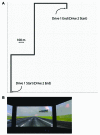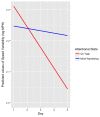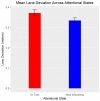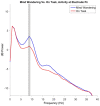Detecting and Quantifying Mind Wandering during Simulated Driving
- PMID: 28848414
- PMCID: PMC5550411
- DOI: 10.3389/fnhum.2017.00406
Detecting and Quantifying Mind Wandering during Simulated Driving
Abstract
Mind wandering is a pervasive threat to transportation safety, potentially accounting for a substantial number of crashes and fatalities. In the current study, mind wandering was induced through completion of the same task for 5 days, consisting of a 20-min monotonous freeway-driving scenario, a cognitive depletion task, and a repetition of the 20-min driving scenario driven in the reverse direction. Participants were periodically probed with auditory tones to self-report whether they were mind wandering or focused on the driving task. Self-reported mind wandering frequency was high, and did not statistically change over days of participation. For measures of driving performance, participant labeled periods of mind wandering were associated with reduced speed and reduced lane variability, in comparison to periods of on task performance. For measures of electrophysiology, periods of mind wandering were associated with increased power in the alpha band of the electroencephalogram (EEG), as well as a reduction in the magnitude of the P3a component of the event related potential (ERP) in response to the auditory probe. Results support that mind wandering has an impact on driving performance and the associated change in driver's attentional state is detectable in underlying brain physiology. Further, results suggest that detecting the internal cognitive state of humans is possible in a continuous task such as automobile driving. Identifying periods of likely mind wandering could serve as a useful research tool for assessment of driver attention, and could potentially lead to future in-vehicle safety countermeasures.
Keywords: EEG; alpha; driving; inattention; mind wandering.
Figures











References
-
- Baldwin C. L., May J. F., Parasuraman R. (2014). Auditory forward collision warnings reduce crashes associated with task-induced fatigue in younger and older drivers. Int. J. Hum. Factors Ergon. 3, 107–121. 10.1504/ijhfe.2014.067804 - DOI
-
- Bates D., Mächler M., Bolker B., Walker S. (2015). Fitting linear mixed-effects models using lme4. J. Stat. Softw. 67, 1–48. 10.18637/jss.v067.i01 - DOI
LinkOut - more resources
Full Text Sources
Other Literature Sources

